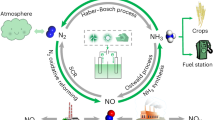Abstract
THIS reaction1 has been reinvestigated using a reaction tube containing a second short filament adjacent to the catalyst filament, so that adsorbed films on the latter might be detected by a measurement of their contact potential2. In this way it was shown that the filament in its most catalytically active state was free from adsorbed oxygen. Under these conditions, as J. K. Roberts3 has pointed out, the clean wire on exposure to gaseous H2 takes up a stable film of hydrogen, which does not evaporate appreciably at room temperature, and so cannot give a para H2 conversion by the mechanism suggested by Farkas1, namely by H2+2W ⇄ 2WH (where W indicates a surface atom of tungsten). It is, however, possible4 that the conversion might occur by a surface interchange reaction of the type pH2 + WH → 0H2+ HW, and this mechanism gains support from the following experiment.
Similar content being viewed by others
References
Farkas, A., Z. physikal. Chemie, B, 14, 371 (1931).
Bosworth, R. C. L., and Rideal, E. K., Proc. Roy. Soc., A, 162, 1 (1937); Bosworth, R. C. L., Proc. Camb. Phil. Soc., 33, 394 (1937).
Roberts, J. K., Trans. Faraday Soc., 35, 941 (1939).
Rideal, E. K., Proc. Camb. Phil. Soc., 35, 130 (1939).
Author information
Authors and Affiliations
Rights and permissions
About this article
Cite this article
ELEY, D., RIDEAL, E. Parahydrogen Conversion on Tungsten. Nature 146, 401–402 (1940). https://doi.org/10.1038/146401d0
Issue Date:
DOI: https://doi.org/10.1038/146401d0
- Springer Nature Limited
This article is cited by
-
Advances on catalytic reduction of 4-nitrophenol by nanostructured materials as benchmark reaction
International Nano Letters (2022)
-
Vibration-driven reaction of CO2 on Cu surfaces via Eley–Rideal-type mechanism
Nature Chemistry (2019)
-
Eley–Rideal, the Other Mechanism
Topics in Catalysis (2018)
-
Development of an innovative validation strategy of gas–surface interaction modelling for re-entry applications
CEAS Space Journal (2016)
-
Sir Eric Rideal FRS and The Rideal Conferences
Topics in Catalysis (2016)





